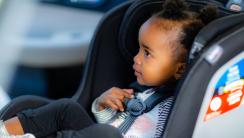Roberts Center for Pediatric Research 2716 South Street, 13th Floor Philadelphia, PA 19146
Breadcrumb
RESEARCH PORTFOLIO
Principal Investigator: Rachel Myers, PhD
The goal of this study is to create a unique source of epidemiologic crash data that enables novel description of use and installation patterns of child restraints among crash-involved children and— following linkage with hospital discharge and death certificate data—novel description of child occupant injury outcomes based on restraint use and installation (rear- vs. forward-facing).2011-2012
- Comparing FMVSS 213 Sled Test to the Full-scale Vehicle Crash Environment (Multiple Year Project)
Principal Investigator: Matthew R. Maltese, PhD
The long-term goal of this study is to determine the effect of geometric and material modifications to the FMVSS 213 bench on the ability of the bench, used in regulatory sled testing, to replicate a real vehicle seat in a crash.- Injury Risk to Belted Occupants (Multiple Year Project)
Principal Investigator: Kristy Arbogast, PhD
The objective of this study is to continue exploration of the injuries and their causation experienced by seat belt restrained occupants - both adults and children - in the rear seat in order to understand if pre-teens and adolescents are at an elevated risk.- Evaluation of Hyperthermia Prevention Technologies
Principal Investigator: Kristy Arbogast, PhD
The objective of this study is to evaluate countermeasures designed to prevent children 0 to 24 months of age from being left behind in closed, parked vehicles, which has the potential to result in hyperthermia.- Dynamic Comparison of Pediatric and the 5th Percentile Female Anthropomorphic Test Devices (ATDs)
Principal Investigator: Thomas Seacrist, MBE
The specific aim is to quantify the kinematics of the head, cervical, and thoracic spine as well as the kinetics of the upper neck of the Q-Series 6-year-old, Q-Series 10-year-old, Hybrid III 10-year-old, and the 5th percentile female ATDs and compare them to age- and size-matched pediatric volunteers.- Clavicle Fractures Due to Belt Loading in Rear-Seated Adolescent Occupants
Principal Investigator: John H. Bolte IV, PhD
The objectives of this research are to investigate the fracture tolerance of the pediatric clavicle through statistical, analytical, and radiological techniques. Using information obtained from crash data, the study will examine the sensitivity of the pediatric shoulder's response to belt loading in both oblique and frontal loading scenarios.- Clavicle Fractures Due to Belt Loading in Rear-Seated Adolescent Occupants
Principal Investigator: Kristy Arbogast, PhD
The objectives of this research are to investigate the fracture tolerance of the pediatric clavicle through statistical, analytical, and radiological techniques. Using information obtained from crash data, the study will examine the sensitivity of the pediatric shoulder's response to belt loading in both oblique and frontal loading scenarios.- Biomechanical Response of the Pediatric Ankle
Principal Investigator: John H. Bolte IV, PhD
Data obtained in this study will provide information on the mechanics of the pediatric ankle joint. Using data regarding the geometry, range of motion, and static/dynamic responses of the ankle, the biofidelity of child ATDs can be improved. Accomplishing a biofidelic response in the child's ankle joint will improve the response of the entire lower extremity, resulting in more accurate prediction of pediatric injury.- Evaluation of Hyperthermia Prevention Technologies
Principal Investigator: Kristy Arbogast, PhD
Principal Investigator: Kristy Arbogast, PhD, The Children’s Hospital of Philadelphia
The objective of this study is to evaluate countermeasures designed to prevent children 0 to 24 months of age from being left behind in closed, parked vehicles, which has the potential to result in hyperthermia.
Principal Investigator: Kristy Arbogast, PhD, The Children’s Hospital of Philadelphia
- Long-term Disability Following Pediatric Trauma
Principal Investigator: Mark R. Zonfrillo, MD, MSCE
The goal of the proposed study is to investigate the nature of the disabilities following pediatric injuries.

